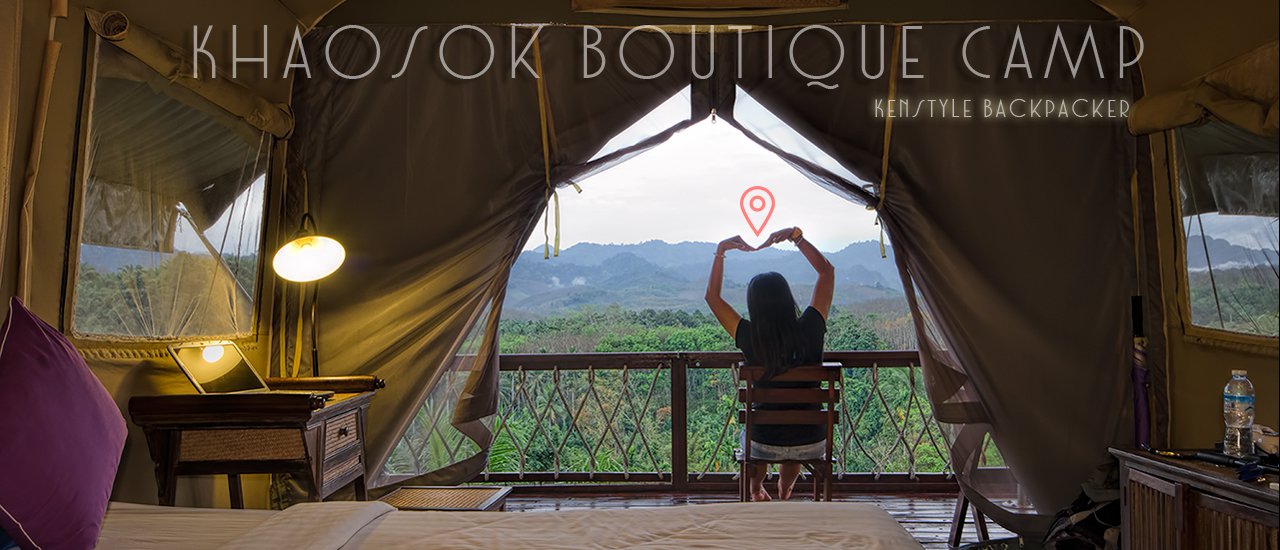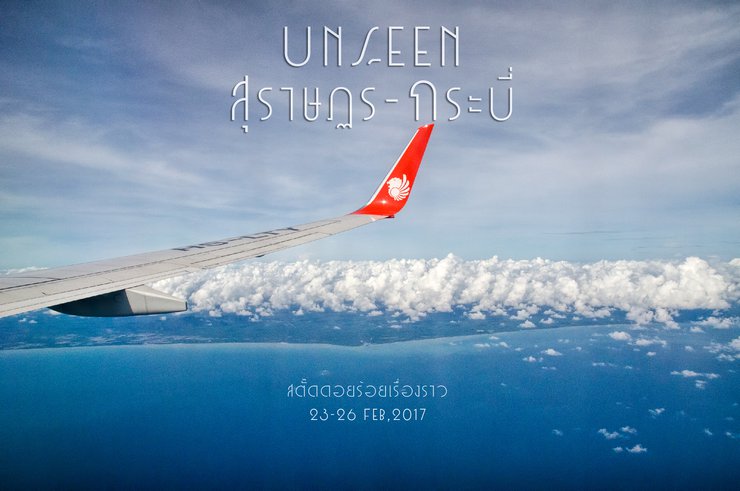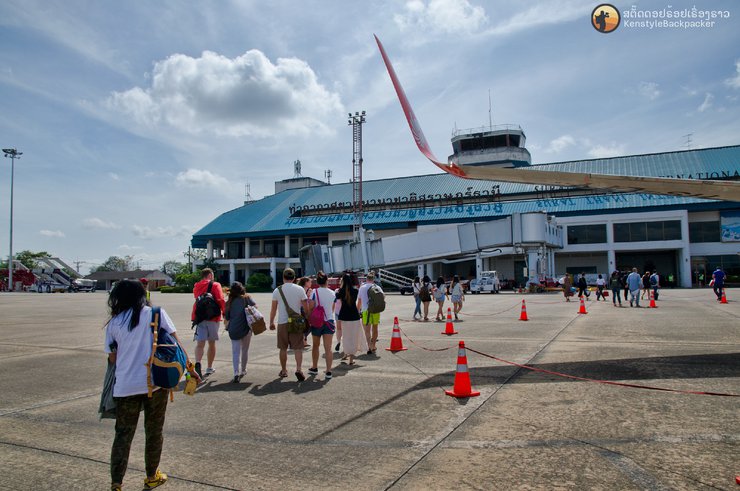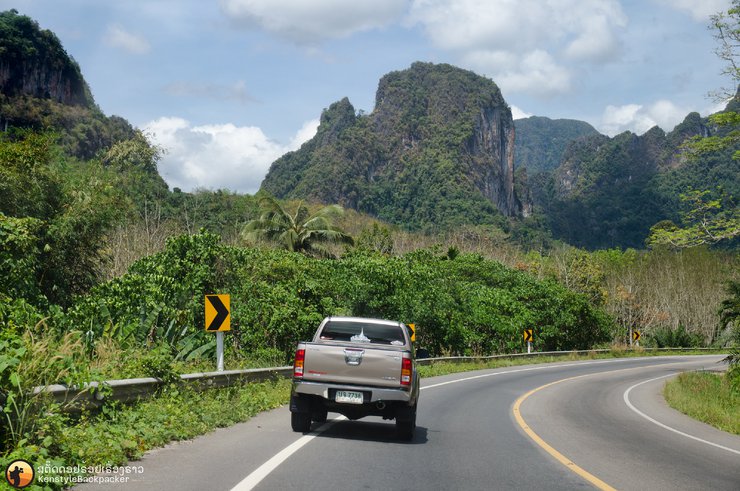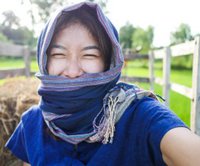As the cool breeze fades and the hot wind begins to blow at the doorstep, many people think of forgetting "him" and turning their attention to the refreshing waters of waterfalls or the sea. Fortunately, our country has many tourist destinations that change with the seasons. In the winter, people go north, and in the summer, they go south or to provinces in other regions with waterfalls. I myself had the opportunity to return to experience the warmth and humidity of the rainforest in the south again. This trip, I traveled with Lion Air from Don Mueang to Surat Thani Airport to... Khao Sok.


Upon arriving at Surat Thani Airport, a pre-arranged shuttle from the accommodation awaited our arrival. Departing from Surat Thani city, we embarked on a journey along Route 401 (Surat Thani - Takua Pa), passing through Ban Ta Khun District, the location of the Cheow Lan Dam, also known as the Ratchaprapha Dam. The route meandered along the boundaries of Khao Sok National Park, offering breathtaking views of towering limestone mountains. After approximately one hour of travel from the airport, we reached our accommodation in Phunom District, covering a distance of approximately 96 kilometers.




Khaosok Boutique Camps
Khaosok Boutique Camp is where I stayed during my two-day trip to Khao Sok. The first thing I noticed when I got out of the car was the heat wave, which was significantly different from Bangkok, indicating that the south was in the midst of summer. I checked in at the counter, where the staff was very welcoming. While waiting for my room, I ordered lunch and explored the common area, which served as both a check-in point and a dining room with a breathtaking view. The resort's location on a gentle slope provided a panoramic view of the mountains stretching out parallel to the accommodation. Naturally, all the rooms must have the same stunning view. In addition, the rubber trees lining the gardens of the nearby villagers were changing color to orange, reminiscent of the fall foliage in foreign countries.






The resort's accommodations are situated on a hillside, with most rooms facing south. The left side faces east, while the right side faces west. The rooms near the pool face directly west. The rooms extend from the hillside to provide panoramic views. They are supported by sturdy concrete pillars or steel structures. All rooms require climbing stairs and have balconies for enjoying nature. The rooms are designed as large canvas tents, divided into sleeping and bathroom areas. The bathrooms are separate shower and toilet rooms and are fully equipped with amenities. The Wi-Fi signal can be weak in rooms further from the central area. This type of accommodation is called Glamping, which combines the camping experience with the comfort of a hotel. It offers all the amenities of a hotel in a tent, catering to tourists who want to experience camping without sacrificing comfort.












Khao Sok National Park: A Paradise for Nature Lovers
While simply relaxing at a resort is an option, a trip to Khao Sok wouldn't be complete without experiencing its diverse range of natural activities. Surat Thani province boasts a variety of adventure and leisure pursuits, and the resort caters to these interests.
Khao Sok's activities fall into two main categories:
1. Exploring the Cheow Lan Dam:
- Boat tours: Enjoy scenic cruises, swim in the refreshing waters, explore hidden caves, and unwind on floating bungalows.
2. Immersing in Khao Sok National Park:
- Rafting, tubing, and canoeing: Navigate the waterways and immerse yourself in the lush surroundings.
- Elephant encounters: Embark on a memorable elephant ride through the jungle.
- Hiking and trekking: Discover cascading waterfalls and explore the park's diverse flora and fauna.
The resort offers comprehensive tour packages that include accommodation, allowing you to choose between overnight stays on floating bungalows or in the heart of the forest. Whether you prefer a 2-day, 1-night or a 3-day, 2-night adventure, there's a package to suit your needs.
For those seeking further exploration, the resort also offers combined tours that extend to the nearby islands of Phang Nga. These packages provide the perfect opportunity to experience both the stunning landscapes of Khao Sok and the island paradise of Phang Nga.
I have already visited the Khao Sok National Park, so this time I decided to relax and do activities on the mainland. My first destination was the park itself, which is only about 10 km from my accommodation. I have been here 2-3 times before but never went inside, so this time I decided to explore the nature trail. I read the signs about the distances to the various attractions within the park and glanced at my watch. It was almost 4 pm, so I wasn't sure how far I would be able to walk. I decided to just see how it went. Strangely, I didn't see any Thai people along the way, only foreigners. I later found out that this spot is more popular with foreigners than Cheow Lan Dam.





The nature trail is characterized by alternating bamboo forests and humid rainforests, with a predominantly flat terrain. After a 30-minute walk covering 1.5 km, the first point, Wang Phai Nga, is reached. Descending to explore, a lone Hanuman langur is encountered, seemingly unafraid of humans. While its demeanor appears non-threatening, vigilance is required as it attempts to steal unattended belongings. Peering into the surrounding foliage reveals groups of langurs lurking, prompting concern over a potential coordinated attack.




The Wang Phaing Nga stream originates from the Thung Nam source, flowing through various islands and rapids before converging into a pool. During the rainy season, the water level is likely higher and deeper. Thung Nam, the source of the Khlong Sok canal, is also the site of Buddhadasa Bhikkhu's floating ashes ceremony. Every October, Buddhist devotees gather to commemorate Buddhadasa Bhikkhu. The source is located approximately 6 kilometers into the forest.



The sweltering heat and the looming rain prompted us to call it a day. With nothing better to do, we decided to take a dip in the water after capturing the surrounding scenery. Our team members took turns standing at different angles to capture the best shots.





Leaving the National Park at around 5 pm, I returned to my accommodation as the rain poured down. I thought to myself that the chances of capturing the sunset from my balcony were slim, but it turned out differently. The rain only lasted a short while, but the atmosphere after the downpour was indescribable. The balcony in front of my accommodation was a bit wet, but it didn't feel as damp as when we were sleeping in tents on the ground. I wanted to walk on the wet footprints on the balcony. The smell of the earth and grass wafted up to my nose. Just sitting still, letting my mind wander and enjoying the view in front of me was like recharging my life energy.






The mist drifted lazily over the rubber treetops, passing through the mountain crevices. The sun began to set, its golden rays illuminating the sky. The light on the ground gradually dimmed, and at a certain point, the golden light of the sky began to turn dark blue, and then the darkness of night took over. The lights from the accommodation helped to make the twilight atmosphere even more beautiful. It must be a scene that repeats itself every day.







After showering and taking care of personal matters, we went to the dining room for a meal. Finding restaurants in the area is a bit difficult, as it is quite remote and most places close in the evening. However, there is a nearby restaurant called "Pa Nee" that serves authentic southern Thai cuisine. The resort's restaurant, "Lomsabai," is open from 7:30 AM to 8:30 PM, with the kitchen closing at 10 PM. I ordered dishes based on the available ingredients, including red curry with ruby fish, stir-fried pork with salt, and shrimp paste chili dip. The flavors were relatively mild, catering to the international clientele. We finished with a dessert of fried bananas with honey, which was quite delicious.






Returning to the room in the late evening, I saw some stars because it was a waning moon. I took a shower and was about to take some pictures of the stars, but the fog started to move in and cover the sky around midnight. So I decided to go to bed. The air was cool at night. I woke up to take pictures of the Milky Way again near dawn, thinking that the fog would have thinned out. But when I opened the tent door, the fog was even thicker than before. So I made a cup of coffee and sat on the balcony waiting for the sun to rise. The air in this area is very humid, and there is often fog in the mornings that makes it difficult to see anything. So I took a walk and took some pictures of the accommodation in the morning before going to breakfast.









Breakfast here is a buffet, beautifully arranged with Thai-style containers on banana leaves. There is a wide variety of food to choose from, both Thai and Western. In the morning, you can sit and enjoy your meal while admiring the view of the mist from the restaurant's balcony, as if you were in a foreign country.







Khao Sok Viewpoint
After breakfast, the resort took me to the Khao Sok viewpoint, located around kilometer 112, approximately 11 kilometers from the resort. This spot offers stunning views of Mount Nang Phrathat when the weather permits. Local legend tells the story of Nang Phrathat, who searched for Phra Sangkh and met her demise at this very location. The mountain range before you, resembling a giant lying down, fuels the imagination. Coincidentally, I had visited this spot once before, and even though the weather was overcast, it didn't dampen the experience. (I couldn't help but wonder if the folktale of Sangkh Thong is specific to the southern region, explaining the giantess's demise here.)





A photo from three years ago shows the mountain in front, which is said to resemble a sleeping giant.

Wat Sak, also known as Wat Tham Nang Phattharatan
We drove back the same way, to the mountain we saw from the viewpoint where Wat Sak is located. This temple is located around kilometer 109, about 8 km from our accommodation, in the same direction as the Khao Sok viewpoint, on the right-hand side. Legend has it that Phra Sangkh hid inside the cave here and escaped, causing the giantess to die of a broken heart. And when the giantess died here, it became the origin of the name Ban Sap, which was later changed to Ban Sak. Currently, the temple is under construction, and there is a statue of Nang Pantu Rat located in front of the cave entrance. Inside the cave, there is a Buddha statue for people to worship. In addition, there is a troop of wild monkeys living in the vicinity, but they are not aggressive. They are quite good-looking and their bodies are clean, unlike the monkeys at Khao Sam Muk. If you pass by, don't forget to stop and feed the monkeys. There is a small entrance fee to the temple for the upkeep of the temple, but I'm not sure if Thai people have to pay because we came in the resort's car, so they didn't charge us.



I climbed the sturdy stairs leading to the cave above, eager to experience the panoramic view. The steep sections required near-vertical ascents. Reaching the vantage point, I peered into the cave's entrance, but without a flashlight and fearing the presence of lurking spirits, I opted to admire the breathtaking vista from the cave's mouth. The elevated perspective offered a remarkable view.






Rafting at Klong Sok
Departing from Wat Sok, we took a car ride for about 2 kilometers before turning right towards Phusak River Canoe. This was the starting point for our next activity: bamboo rafting. We enjoyed the scenery on both sides of the Sok Canal, which resembled the Nam Song River in Vang Vieng, but with a more relaxed atmosphere. As we drifted along, the raftsman told us that during the rainy season, the water level rises significantly, sometimes even flooding the surrounding rubber plantations. He even mentioned that sometimes they have to use boats to tap rubber trees. One side of the Sok Canal is lined with rubber plantations, while the other side borders limestone mountains that the canal winds through. We could hear the haunting cries of gibbons from the treetops that covered the mountains, but despite our best efforts, we couldn't spot them.






After about 15 minutes of rafting, the uncle who was steering the raft took us to the bank next to the mountain. He said he wanted to stop for a drink and make some tea and coffee. We thought we were going to his house for a drink, but he told us to walk straight along the path. To our surprise, it was a simple coffee shop run by villagers on the side of the mountain. There were not many tables, and the coffee was brewed in a bamboo tube with pandan leaves covering the opening. At first, we thought they were going to burn sticky rice, but the tube was too big, so it must not have been. They used bamboo cups to pour the boiled water and drink it plain. It smelled strongly of pandan leaves. After sitting and drinking coffee for a while, we continued rafting. The whole activity took about an hour, and before we left, the uncle gave us a cup as a souvenir.






Khaosok Discovery Observation Camp
During the day, we stopped for lunch at the resort's restaurant, which is open to guests only. The restaurant is located in a shady palm grove and is decorated with natural materials that blend seamlessly with the surroundings. The food tastes exactly the same as at the resort, so it must be the same chef! ^^











Khao Na Nai Luang Dharma Park
In the evening, I embarked on a journey to a new and relatively unknown tourist destination in Surat Thani province. I had previously seen it featured on the TV show "Anuwat Jad Hai," and since it was located near Khao Sok National Park, I decided to pay it a visit. Traveling from my accommodation, I drove back about 61 kilometers and turned right at a three-way intersection, continuing for another 20 kilometers towards Kiansa. This place, known as Wat Khao Na Nai, was a considerable distance from my accommodation, approximately 60 kilometers. Upon arriving at the temple, the first thing that caught my eye and served as the highlight of my visit was the entrance gate, which was designed as an archway resembling an entrance to an ancient kingdom. This gate, called the "Suum Pra Tu Puthawadee 9 Yot," had previously captured my attention in an online image where golden beams of light streamed through the arch, creating a stunning visual. I had assumed this occurred during sunset, but I later learned that this angle is best captured during sunrise. As a result, I attempted to edit the photo to simulate a sunset scene as a temporary solution.


In addition to the gatehouse, there is a floating pagoda called Phra That Phan Ngoen, which houses the relics of the Buddha. The pagoda and gatehouse are built from laterite stone from Kamphaeng Phet Province. The ascent to the pagoda requires climbing steep stairs to the top of the limestone mountain, but the walk is not too tiring. However, elderly people with bad knees may not be able to make the climb. Inside the pagoda, there are relics of the Buddha for worship. The view from here is very beautiful, and if you come in the morning, you will see a sea of fog.









The rain started again just as I was about to take a few photos. This is typical of the weather in southern Thailand. One moment the sky is clear and the sun is shining, and the next it's raining. There's even a local song that mocks this unpredictable weather: "Farewell, girl of Phang Nga, farewell to the skies of Phuket. These two things are liars, you can't trust them after six or seven times." But hey, we're in Surat Thani now... maybe it's just catching on from nearby.
Check Out
The next morning, the fog still blanketed the area. We captured the last moments of the scenery before checking out and heading to Krabi. I forgot to mention that we moved to another cabin on the west side yesterday. Unfortunately, it rained after we returned from Wat Na Nai, and it was already dark when we arrived back at the resort, so we missed the sunset behind the mountains.






With my luggage packed and ready to board the vehicle, the sky began to clear, the fog dissipated, and the heavens grew brighter. I took a moment to capture the scene with my camera.








I took the opportunity to visit the rooms that guests had checked out of and the housekeepers were cleaning. The rooms were similar in layout, but differed in size, bed type (double or single), and view.






The Tree of Enlightenment and the Blooming Lotus
If you come to Khao Sok and don't see the blooming lotus, it's like you haven't been to Khao Sok at all. Plus, it's the provincial flower. This is the time when it's in full bloom. I've been wondering about this ever since I first learned that it takes a long time to get to see the blooming lotus. The first day, there wasn't enough time. The second day, I was busy with activities all day. On the third day, before going to Krabi, I wanted to stop by to satisfy my curiosity. But before going to see the blooming lotus, there is another unseen spot in the park. When you walk into the park, just past the park sign, walk along the edge of the stream and look up. Warning: Children and adults, please use your imagination to see the picture. How is it? Let's zoom in a bit. Two trees are growing on top of each other. The branches, stems, and leaves of both trees form a shape that looks like a Buddha statue sitting in meditation with hands in prayer position.



After visiting the Bodhi Tree, we were unsure how to reach the blooming lotus flowers. Fortunately, the district officer had arranged for park rangers to guide local NBT reporters to capture footage of the flowers. Ms. Pat, the manager of Khao Sok Boutique Camp, who knew the rangers, allowed me to join their team. The trek to the lotus flowers from the park entrance is quite long, so we opted for a shorter route near the Khao Sok viewpoint. A sign marking the park boundary and a wooden staircase can be found along the roadside. It's important to note that accessing the viewpoint requires prior permission from park officials; unauthorized entry incurs a 500 baht fine. The roundtrip hike takes approximately 3-4 hours and involves a gradual ascent without steep inclines.



The Rafflesia: A Giant Among Flowers
The Rafflesia, a genus of parasitic plants, boasts the title of the world's largest flower. The Rafflesia arnoldii, found in Indonesia, can reach a staggering 100 centimeters in diameter. Even the smaller Thai Rafflesia kerrii, with its 50-90 centimeter blooms, is a sight to behold. When these flowers emerge from the lush rainforest floor, their vibrant crimson hue creates a truly breathtaking spectacle.
Known as "bua tum" by locals in southern Thailand, the Rafflesia is a root and stem parasite that relies on the Tetrastigma vine, also known as "yaan kai tom," for its survival. The Rafflesia draws nutrients and water from its host, which remains alive throughout the parasitic relationship.
The Rafflesia only becomes visible when it seeks to reproduce. Tiny flower buds appear on the surface of the yaan kai tom vine and grow to the size of a giant cabbage over nine months. The flower then blooms for a maximum of seven days within a year. However, due to the separate male and female flowers, successful pollination by flies requires perfect timing, making the Rafflesia highly vulnerable to extinction.
Source: http://khaosok.holidaythai.com/




To protect the fragile ecosystem of the lotus field, visitors must follow the designated paths marked by ropes. Stepping off the path risks damaging the delicate plants, including young shoots that may not be visible. These shoots take nine months to mature and bloom for only seven days. To prevent accidental damage, park rangers have installed bamboo fences around the area. This measure was prompted by a social media post showing a tourist kneeling near a lotus flower, inadvertently crushing a young shoot. The image serves as a reminder of the importance of respecting the environment and following park regulations.


Suspension Bridge of Khao Theppitak
The final stop is the Wat Khao Phang Suspension Bridge, also known as Khao Theppitak Bridge or Khlong Saeng Suspension Bridge. This newly developed ecotourism destination is located near the entrance of the Cheow Lan Dam in the Khao Phang Subdistrict Administrative Organization. The bridge is a cable-stayed structure with a wooden plank deck supported by a steel frame. Standing on the bridge, visitors can enjoy the natural beauty of the Khlong Phasang Canal on both sides. The highlight of the bridge is the heart-shaped mountain in the background. This small hill has been naturally sculpted into a heart shape, creating a picturesque backdrop.









This concludes my 3-day, 2-night trip to Surat Thani. My journey continues as I head to Krabi province. Stay tuned for my next review, "Traveling Krabi in Style." For this trip, I would like to express my gratitude to P'Pom from Khaosok Discovery, P'Pat, and the Khaosok Boutique Camps team for their support in making this review possible.
Visit and inquire about accommodation prices at this link click
Khao Sok Travel Map click

- Thank you to all my friends who have come to watch, like and share. Your support means a lot to me.
- Exchange information or ask for travel information Fanpage: Studdoy Hundred Stories
- Follow our previous articles here: All travel trips
The original text is empty. Please provide the text you want me to translate.
สตั๊ดดอย ร้อยเรื่องราว
Friday, October 4, 2024 3:20 PM

